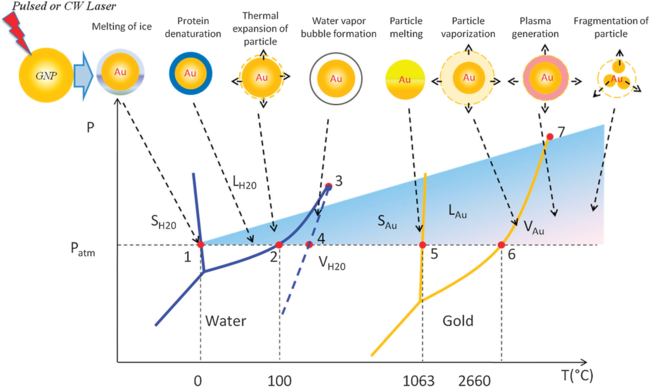Qin:Research: Difference between revisions
Zhenpeng Qin (talk | contribs) No edit summary |
Zhenpeng Qin (talk | contribs) No edit summary |
||
| Line 27: | Line 27: | ||
Powered by <html><a href="http://www.openwetware.org"><img src="http://openwetware.org/images/0/01/80x15_openwetware.png" border=0/></a></html> | Powered by <html><a href="http://www.openwetware.org"><img src="http://openwetware.org/images/0/01/80x15_openwetware.png" border=0/></a></html> | ||
<br> © 2014 Zhenpeng Qin | <br> © 2014 Zhenpeng Qin | ||
Revision as of 14:42, 26 August 2014
Our laboratory focuses on fundamental understanding of the bio-nano interface and translating this to biomedical applications. Current efforts focus on the thermo-plasmonic fundamentals and its effects at the interface between biological systems and nanomaterials. Specifically, experimental techniques and methods will be developed to understand the effects of nanoparticle plasmonic heating on proteins and other biomolecules immediately surrounding the nanoparticle. This can lead to new enabling tools for fundamental research, and to applications in both diagnostic and therapeutic areas.
Fundamentals of Thermo-Plasmonics
Plasmonic absorption of light by metal nanoparticles can generate significant amount of heat, leading to different thermophysical events as shown in Fig. 1. Although increasingly used by biomedical applications, the fundamentals of these thermophysical events are not well understood, especially with the nanoscale confinement and curvature. Our laboratory is interested in developing experimental and computational methods to improve the understanding of these fundamental thermophysical processes.
Fig. 1 Schematics of thermophysical responses of thermo-plasmonic heating shown in a phase diagram. Figure is from Qin et al. CSR 2012
Biomedical Applications of Thermo-Plasmonics
A compelling vision in nanomedicine is the use of self directed nanoparticles that can accumulate in areas of disease to perform designed functions, such as molecular delivery or destruction, endosomal release of genes or siRNA, and selective cell or tumor destruction with nano to macroscale spatiotemporal control and precision. These functions are increasingly achieved by gold nanoparticles (GNPs, such as sphere, shell or rod) that can be activated with a laser ‘‘switch’’. A defining aspect of this ‘‘switch’’ is GNP absorption of laser light and the ensuing heat generation and temperature change (i.e. thermo-plasmonics) that can be confined or propagated through multiple scales from the nanoparticle surface up through bulk biological cells and tissues. Our laboratory is interested in developing novel biomedical applications of thermo-plasmonics for fundamental research in cell biology, and for applications in disease diagnostics and therapeutics.
Fig. 2 Overview of example biomedical applications of thermo-plasmonic heating of gold nanoparticles. Figure is from Qin et al. CSR 2012
Powered by <html><a href="http://www.openwetware.org"><img src="http://openwetware.org/images/0/01/80x15_openwetware.png" border=0/></a></html>
© 2014 Zhenpeng Qin


